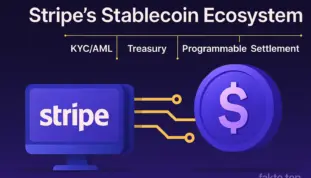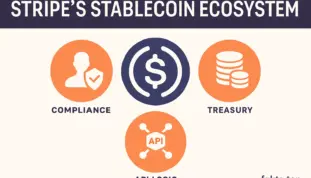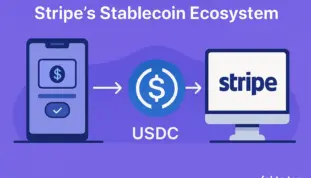Stripe’s Stablecoin Ecosystem: KYC, Treasury, and Programmable B2B Settlement
From Fiat to Tokenized Trade: Analyzing Stripe’s Role in B2B Stablecoin Settlement
Stripe’s integration of USDC is more than a technical update—it’s a strategic inflection point in the evolution of programmable finance. While most headlines focus on the surface-level announcement, the deeper transformation lies in Stripe’s emergence as a compliance-first infrastructure layer for B2B stablecoin settlement.
For developers and product managers, Stripe unlocks new programmable commerce use cases. For financial directors, it offers cost savings, compliance clarity, and real-time cross-border settlement. Stripe is not merely accepting stablecoins—it is building the bridge between regulated fiat systems and Web3 finality.
This article explores Stripe’s stablecoin ecosystem through four lenses: regulatory compliance, treasury efficiency, programmable API logic, and strategic positioning. Each section integrates long-tail semantic keywords and real-world use cases to provide actionable insight for enterprise adoption.
Stripe KYC/AML Solutions for Crypto: Liquidation of Regulatory Risk
One of the most persistent barriers to corporate crypto adoption is regulatory uncertainty. Stripe addresses this challenge directly with a robust KYC/AML framework tailored for stablecoin flows. By embedding identity verification into its on-ramp and off-ramp processes, Stripe transforms compliance from a bottleneck into a built-in feature.

Stripe’s system verifies users, partners, and vendors across jurisdictions, ensuring that every transaction meets regulatory standards. This is especially critical for B2B crypto payments, where auditability and counterparty trust are non-negotiable. Stripe’s compliance layer DeFi infrastructure enables businesses to move capital with confidence, knowing that every step is verified and logged.
Stripe Connect Crypto Compliance and the Partner Ecosystem
At the core of Stripe’s compliance architecture is Stripe Connect—a modular system that allows platforms to manage sub-merchants and partners. In the context of stablecoins, Connect ensures that every participant in a transaction flow adheres to the same KYC/AML standards.
Platforms can onboard vendors, creators, or affiliates without building their own compliance stack. Stripe handles verification, monitoring, and reporting, allowing businesses to scale their stablecoin operations while maintaining regulatory integrity. This partner ecosystem transforms Stripe from a payment processor into a compliance orchestrator.
For developers, this means faster integration and reduced legal overhead. For financial directors, it means fewer risks and clearer audit trails. Stripe Connect crypto compliance is not just a feature—it’s the foundation for enterprise-grade stablecoin adoption.
Stablecoin Treasury Management and the B2B Cost Revolution
Beyond compliance, Stripe’s stablecoin infrastructure offers a compelling financial advantage. Traditional SWIFT wire transfers are slow, expensive, and opaque. Stripe’s USDC integration enables near-instant settlement with dramatically lower fees, unlocking new efficiencies for treasury teams managing cross-border flows.
| Metric | SWIFT Wire Transfer (Avg.) | USDC via Stripe (Avg.) |
|---|---|---|
| Transaction Cost | $20–$50 + FX fee | 0.1%–1% + gas (negligible) |
| Latency (Settlement Time) | 2–5 business days | Seconds (Real-time gross settlement DeFi) |

This efficiency contrasts sharply with the challenges of traditional SWIFT wire transfers [INTERNAL LINK: SWIFT Challenges]. For financial directors, the ability to move capital globally in seconds—without intermediary banks or FX slippage—represents a paradigm shift in treasury management.
Moreover, Stripe supports fiat off-ramp efficiency [INTERNAL LINK: Crypto Off-Ramps], allowing businesses to convert stablecoins into local currency with minimal delay. This end-to-end flow—from tokenized payment to fiat redemption—positions Stripe as a full-stack treasury solution for the Web3 era.
Scenario: Global Supplier Payments
A multinational e-commerce platform needs to pay hundreds of suppliers across Asia, Africa, and Latin America. Traditional SWIFT transfers introduce delays, FX fees, and reconciliation headaches. With Stripe’s USDC on-ramp, the platform can initiate real-time gross settlement DeFi transactions, reducing latency from days to seconds and slashing costs by over 80%.
Compliance is handled natively: each supplier is onboarded via Stripe Connect, with KYC/AML verification embedded in the payout flow. Treasury teams gain visibility, auditability, and speed—all within Stripe’s dashboard.
Programmable Commerce API Stablecoin Use Cases: Unlocking Web3 Logic
Stripe’s stablecoin integration is not just a faster payment method—it’s a programmable financial layer. Through its API-first architecture, Stripe enables developers to embed conditional logic into payment flows, unlocking use cases that were previously impossible with legacy rails.

For developers and product managers, this means building financial workflows that respond to real-time data, user actions, and smart contract conditions. Stripe’s programmable commerce API stablecoin model supports dynamic, logic-driven operations across industries.
Use Case: Conditional Payouts
Imagine a freelance platform that releases USDC payments only after verified task completion. Stripe’s API handles identity verification, monitors task status, and triggers settlement—all within a single programmable flow. This reduces fraud risk and eliminates manual reconciliation.
Use Case: Real-Time Royalties
Content platforms can automate royalty distribution based on usage metrics. Stripe enables instant, compliant payouts to creators, improving transparency and reducing operational overhead. This is especially valuable for global ecosystems with diverse payout structures.
Use Case: Tokenized Asset Redemption
Platforms offering tokenized assets—such as real estate shares or digital collectibles—can use Stripe to verify user identity, confirm asset ownership, and release stablecoin payouts. This simplifies redemption logic and ensures compliance across jurisdictions.
[VISUAL ASSET: API Flowchart]
Scenario: SaaS Royalty Distribution and Tokenized Platforms
A SaaS company with a global partner ecosystem needs to distribute monthly royalties based on usage. Previously, this required manual calculations and batch wires. With Stripe’s programmable API, the company automates royalty logic: usage triggers payout, verified identity triggers release, and USDC settles instantly.
Similarly, a platform offering tokenized IP rights can use Stripe to validate ownership and automate payouts. These flows are not just efficient—they’re scalable, auditable, and compliant by design.
Strategic Positioning: Stripe’s Role in the Web3 Infrastructure Stack
Stripe’s stablecoin ecosystem is not a bolt-on feature—it’s a strategic architecture designed to support regulated programmable finance. By embedding compliance, treasury, and logic into a single API layer, Stripe positions itself as the connective tissue between fiat systems and decentralized protocols.
This positioning is especially relevant as enterprises explore tokenized trade, on-chain invoicing, and programmable escrow. Stripe’s infrastructure allows these workflows to operate within regulatory boundaries, without sacrificing speed or flexibility.
Competitive Landscape: Stripe vs. Legacy Rails
Compared to legacy payment systems like SWIFT, ACH, and correspondent banking, Stripe offers a radically different value proposition. Traditional rails are built for batch processing and multi-day settlement. Stripe’s stablecoin flows deliver real-time gross settlement DeFi, programmable logic, and embedded compliance.
While legacy systems require reconciliation, FX hedging, and manual compliance checks, Stripe automates these processes. The result is lower cost, higher speed, and better transparency. For enterprises operating globally, this shift is not just technical—it’s strategic.
The Compliance Layer DeFi Infrastructure
At the heart of Stripe’s model is a compliance layer that integrates identity verification, transaction monitoring, and jurisdictional logic into every API call. This infrastructure enables businesses to operate across borders and sectors without building bespoke compliance stacks.
Whether onboarding a vendor in the EU or settling a payout in Southeast Asia, Stripe handles the regulatory complexity behind the scenes. For enterprises, this means faster deployment and lower legal risk. For regulators, it means better visibility and control.
Stripe’s compliance layer DeFi infrastructure [INTERNAL LINK: Web3 Compliance Layer] is not just a technical achievement—it’s a strategic enabler of global B2B stablecoin adoption.
Conclusion: Stripe as the Regulated Gateway to Real-Time B2B Settlement
Stripe’s stablecoin ecosystem represents a convergence of speed, compliance, and programmability. For financial directors, it offers a cost-effective alternative to SWIFT. For developers, it unlocks new logic layers for programmable commerce. And for the broader Web3 economy, it provides the missing link: a trusted, regulated gateway between fiat and tokenized trade.

As real-time gross settlement DeFi becomes the norm, Stripe is positioned to lead the B2B transformation. Its infrastructure doesn’t just process payments—it orchestrates compliance, treasury, and logic in a single API layer. The future of corporate finance is not just faster—it’s programmable, auditable, and on-chain.
Disclaimer: This article is for informational purposes only and does not constitute financial, legal, or technological advice. fakto.top does not endorse any specific financial product or protocol. Readers should conduct their own due diligence and consult professional advisors before making decisions related to crypto assets or payment infrastructure.
Conclusion: Stripe as the Regulated Gateway to Real-Time B2B Settlement
Stripe’s stablecoin ecosystem is more than a technical upgrade—it’s a strategic redefinition of how businesses interact with money, compliance, and programmable infrastructure. By integrating USDC into its platform with embedded KYC/AML, real-time settlement, and modular APIs, Stripe positions itself as the regulated gateway to the B2B Web3 economy.
For financial directors, Stripe offers a treasury management solution that outperforms legacy systems in cost, speed, and auditability. For developers, it unlocks programmable commerce use cases that were previously impossible without building custom compliance stacks. And for enterprises navigating global operations, Stripe provides a unified infrastructure for tokenized trade, fiat off-ramping, and cross-border liquidity.
As programmable finance becomes the norm, Stripe’s architecture will serve as the connective layer between traditional finance and decentralized protocols. It doesn’t just process payments—it orchestrates trust, logic, and finality. The future of B2B settlement is not just faster—it’s programmable, compliant, and on-chain.
Disclaimer: This article is for informational purposes only and does not constitute financial, legal, or technological advice. fakto.top does not endorse any specific financial product or protocol. Readers should conduct their own due diligence and consult professional advisors before making decisions related to crypto assets or payment infrastructure.
Conclusion: Stripe as the Regulated Gateway to Real-Time B2B Settlement
Stripe’s stablecoin ecosystem is not a temporary experiment—it’s a foundational shift in how regulated finance and programmable money converge. By embedding compliance, treasury logic, and API programmability into a unified infrastructure, Stripe enables enterprises to operate across borders, partners, and jurisdictions with speed and trust.
For financial directors, Stripe offers a treasury management solution that outperforms legacy systems in cost, latency, and auditability. For developers, it unlocks programmable commerce flows that are secure, scalable, and compliant by default. And for platforms navigating tokenized trade, Stripe provides the missing link: a regulated gateway between fiat and Web3 finality.
As programmable finance becomes standard, Stripe’s architecture will serve as the connective layer between traditional finance and decentralized protocols. It doesn’t just process payments—it orchestrates trust, logic, and finality. The future of B2B settlement is not just faster—it’s programmable, compliant, and on-chain.
Disclaimer: This article is for informational purposes only and does not constitute financial, legal, or technological advice. fakto.top does not endorse any specific financial product or protocol. Readers should conduct their own due diligence and consult professional advisors before making decisions related to crypto assets or payment infrastructure.
